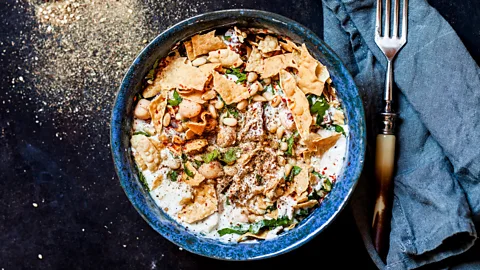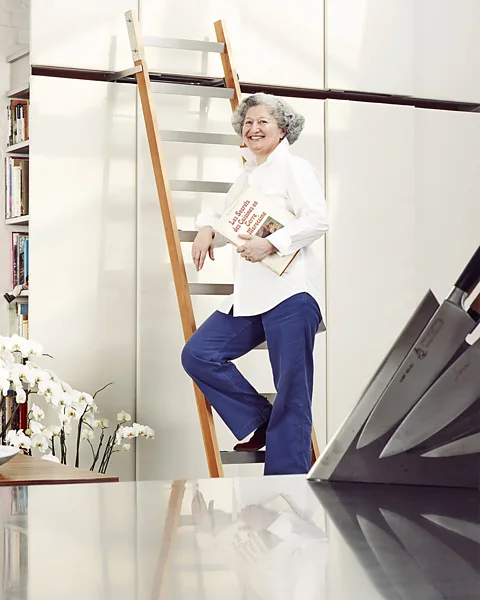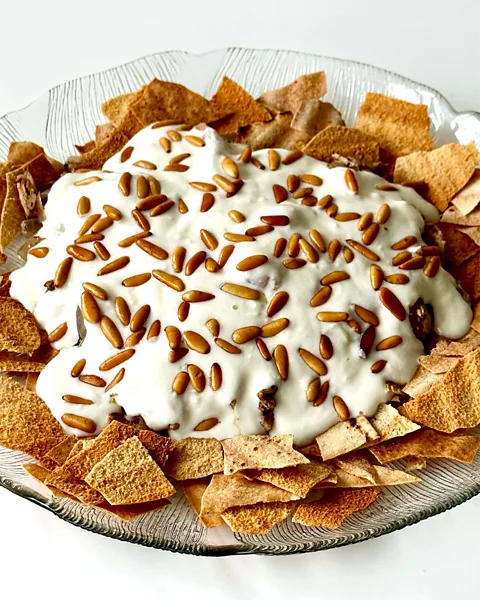Fatteh: a layered dish of bread and yoghurt
 Westend61 GmbH/Alamy
Westend61 GmbH/AlamyIt's a great contrast of textures, with crispy toasted pita, smooth yoghurt, crunchy pine nuts, juicy chicken and chickpeas, and is the perfect dish for Ramadan and Eid.
Of all the traditional meals found in Lebanon, fatteh, a layered dish of poached meat or chicken, chickpeas, toasted pita bread and garlic yoghurt topped with pine nuts, might be the simplest to prepare – and one of the tastiest.
Fatteh has a long history in Middle Eastern culture, appearing to originate in Egypt and later in the Levant. There are endless ways to make it across the region – such as with or without tomato sauce, adding sheep trotters, layering in small stuffed eggplant – but no matter what, fatteh traditionally uses up day-old flatbread and is soaked in broth or yoghurt.
It's possible that fatteh evolved from a Pharaonic dish called fotat, which in Arabic means crumbs, or small pieces. The dish also shares similarities with tharid, said to be the Prophet Mohamed's favourite dish, which is made with thin, toasted bread that's covered with broth, meat and vegetables.
According to Anissa Helou, a Lebanese chef and cookbook author who won the Foodics Icon Award as part of Middle East & North Africa's 50 Best Restaurants 2023, "If you follow the notion and concept of the dish, it ties in with tharid, considering it's multi layered."
Fatteh has long been a convivial dish. It was served during the Fatimid Caliphate in Egypt from 969-1171 CE, when rulers would provide street feasts for Eid al-Fitr, the Islamic event marking the end of a month of fasting during Ramadan. It was also eaten regularly at great banquets held by the heads of state during the Ottoman Empire in the 15th and 16th Centuries. Now, it's considered a staple dish for iftar, the meal eaten by Muslims to break their daily fast during Ramadan.
 Phil Fisk
Phil FiskFor her take on the dish, Helou prepares a classic Lebanese version, which she learned to make from her mother 30 years ago. She said her recipe – which appeared in her first cookbook, Lebanese Cuisine – is typical for the Maronite Christians in the mountains of Lebanon where she is from. She noted that even within Lebanon the dish varies from the south to the north. Nevertheless, in each household it marks an important place on the table.
"Fatteh is a very important dish in the Lebanese repertoire… and for me, fatteh is a great dinner party dish," Helou said. "You can prepare everything ahead of time and just assemble it at the last minute."
Helou's fatteh recipe starts with a base layer of toasted pita bread, topped with chicken and chickpeas, a ladle of broth, then a minced garlic yoghurt mixed with tahini, which adds more body and a nutty flavour.
The final dish gives a great contrast of textures, with crispy toasted pita, smooth yoghurt, crunchy pine nuts, juicy meat and chickpeas. A vegetarian version is also simple to make, using aubergine instead of meat.
 Anissa Helou
Anissa HelouServes: 4
Ingredients
200g (7oz) chickpeas, or one 400ml can of chickpeas, drained
1 tsp baking soda
1kg (just over 2lb) boneless chicken
4 or 5 chicken bones (optional)
3 cinnamon sticks
1 tbsp coarse sea salt, plus more for seasoning
1 large pita bread, opened
olive oil (optional)
50g (3½ tbsp) unsalted butter
60g (2oz) pine nuts
1 garlic clove, peeled and crushed
10g fresh mint leaves crushed with the garlic (optional)
1 tbsp tahini
900g (32oz) yoghurt (Greek-style)
Method
Step 1
If you are using dried chickpeas, put them in a large bowl to soak in three times their volume of water (about 3 cups), as they will double in size. Stir in one tsp of baking soda to soften them and therefore help reduce their cooking time. Soak overnight.
Step 2
Rinse the chickpeas under cold water, put them in a saucepan, cover with fresh water and place over medium heat. Bring to a boil, cover and cook for 1 hour, or until they are tender. Drain and set aside.
Step 3
Put the chicken and bones (if using) in the same saucepan, add 1.2 litres (5 cups) of water and place over medium heat. As the water is about to boil, skim the surface clean; this is an important step to keep the flavour clean tasting. Add the cinnamon sticks and salt, cover the pan and boil gently for 45 minutes or until the meat is very tender. If using a can of chickpeas, add once the meat is cooked, just to heat them. Keep warm over a very low heat ahead of serving.
Step 4
Meanwhile, toast the bread in a hot oven or under the grill until golden, no more than 5 minutes; let cool. (Drizzle olive oil over the bread before toasting, if desired.)
Step 5
In a frying pan, melt the butter and sauté the pine nuts, stirring regularly, until golden brown; watch them so they don't burn. Remove with a slotted spoon onto a double layer of kitchen paper and leave to drain.
Step 6
Mix the crushed garlic (and mint if you chose to use it) and tahini into the yoghurt. Add salt to taste. Set aside.
Step 7
Break the toasted bread into bite-sized pieces and spread over the bottom of a deep serving dish. Take the meat out of the stock, cut it into bite-sized pieces and spread over the bread. Remove the chickpeas with a slotted spoon and spread over the meat. Sprinkle a couple tablespoons of the chicken stock over the meat and chickpeas and cover with the seasoned yoghurt. Garnish with the sautéed pine nuts. Serve immediately.
Tips:
Pine nuts are too expensive can easily be substituted for slivered almonds or even cashews.
Helou suggests buying whole chicken to boil and then shred the meat off the bone, in order to have a richer broth than when using deboned chicken.
BBC.com's World's Table "smashes the kitchen ceiling" by changing the way the world thinks about food, through the past, present and future.
---
more than three million BBC Travel fans by liking us on Facebook, or follow us on Twitter and Instagram.
If you liked this story, sign up for the weekly bbc.com features newsletter called "The Essential List". A handpicked selection of stories from BBC Future, Culture, Worklife and Travel, delivered to your inbox every Friday.
